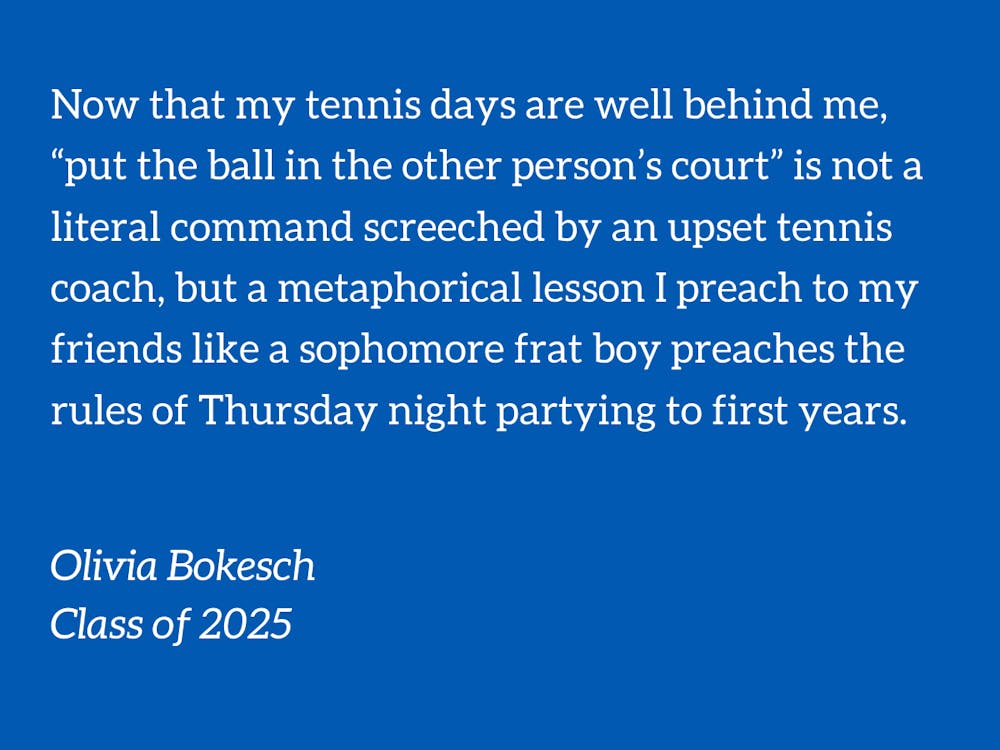If my burnt-out-by-age-15 competitive tennis career taught me anything, it was to always put the ball in the other person’s court. I vividly remember sweltering South Carolina days with my Pitbull (Mr. Worldwide, not the dog) look-alike coach shouting this concept at me and eight other kids from the comfort of his courtside umpire chair. In theory, always putting the ball in the other person’s court with 100% success means that they will eventually lose. They will volley the ball into the net, overhit the ball and send it hurdling over the back fence or miss the ball completely. You are sure to win.
Now that my tennis days are well behind me, “put the ball in the other person’s court” is not a literal command screeched by an upset tennis coach, but a metaphorical lesson I preach to my friends like a sophomore frat boy preaches the rules of Thursday night partying to first years.
So, how do you metaphorically put the ball in another person’s court?
Say you are talking to someone you are interested in—whether it be romantically, platonically, or otherwise—and it is too vulnerable of a situation, too early in the relationship to know if meeting up would be chill with the other person. You do not want to be the one to make that first move and set up a lunch meetup or a coffee date because if they’re not interested and awkwardly decline the offer, suddenly the embarrassment is on you. You’ve lost. So, instead of coming up with a solid plan, you send this message: “if ur ever free and want to hang lmk.” Simple, nonchalant, but most importantly, puts the ball in their court. Now, they are the one who must hit you up if they ever want to hang. If they do hit you up, now you know they’re interested without ever having to fully put yourself out there and be exposed. If they never hit you up, now you know, and it is less of an embarrassment for you. You win either way.
Yet, like any fantastic, totally infallible plan, there is a downside.
If both people are playing the “put the ball in the other person’s court” game, then the rally could go on forever with no one winning and no one losing—worst case scenario is someone quits out of exhaustion. Outside of tennis, there are no line judges or chair umpires to pull up an instant replay and prove that a shot was good. I’ve been the messenger enough between friends, to know that even when someone is telling you a person’s intentions word-for-word, it is hard to act on this knowledge if there is no reassurance (like instant replay) from the person themselves. There is no way to completely eliminate the fear of letting a person know how you feel without knowing for certain that they feel the same way.
Where did this fear of vulnerability and of allowing our full intentions to be known come from? One could argue that this is just how college kids are. We are still figuring out who we are and who we want to be, so we are even less sure where other people stand.
Maybe it is not entirely on us though. It is no secret that in a world where we can see what other people are up to all the time, there is pressure to present ourselves a certain way. We are constantly inundated with Snapchat stories of people’s aesthetic lake days, Instagram posts of their most recent successes, and pictures of perfect bodies, faces, lives etc. In recent years there has been pushback against only showcasing the perfect parts of life, but in all honesty, social media is a highlight reel at best and fake authenticity at worst. Even the latest Instagram trend of “photo dumps,” where people share “random” photos from their camera roll in an attempt to dismantle the fakeness of social media, is a curated post, carefully crafted to show the personality of the person that they want you to see.
Conscious or not, we all have a hyper awareness of the way people perceive us and the way we perceive others due to our experiences with social media. Since most college kids interact with social media every day, it is not outlandish to claim that this hyperawareness has seeped into the part of our lives that we do not share online. In turn, we have become more cognizant of how the way we interact with others can reveal our vulnerabilities and allow others to judge and change their perception of us.
If we do not consistently put the ball in the other person’s court, we risk losing control over how they think of us. Will they see me as weak if I reveal my true thoughts first? Will they laugh with their friends over what I said or did? Will they think that the person I portray myself to be is a falsehood? Being vulnerable enough to be your full self can be frightening. However, the upside of being vulnerable is that it means letting go of the media narrative that we must be who we are online and letting go of the control we feel we must have over how people think of us.
Tennis player, or not, we could all use the advice from an old tennis coach of mine to conquer our fear of vulnerability: “Never apologize for hitting a ball outside of the court. It lands where it lands and it’s up to you to decide the direction you want the next point to take.”
Olivia Bokesch is a Trinity first-year. Her column typically runs on alternate Wednesdays.
Get The Chronicle straight to your inbox
Signup for our weekly newsletter. Cancel at any time.

